FY2021 Annual Report
Quantum Machines Unit
Professor Jason Twamley

Abstract
The Quantum Machines Unit works on how to build functionally useful devices from disparate quantum systems. The Quantum Machines Unit started in July 2020 and in one year has now fully established experimental and theoretical efforts and the team has grown to 8 postdocs and 2 PhD students. The Unit hosted one rotation student in Term 2 [2021], working on theory related to optofluidics. These rotation projects each focused on some aspect relating to the magnetic levitation of quantum systems and this interdependence meant that the rotation students could more easily understand/relate/assist each other during their rotation.
Over the past year the Unit has hosted a vibrant series of seminars both online and in-person. The Unit operated a small meeting on levitated quantum systems with speakers from Gakushuin University and Osaka University – this was a live meeting and not online. In addition the Unit hosted an undergraduate intern student from Hokkaido University in Japan. The Unit was also one of the main organisers of the international workshop on Quantum Engineering of Levitated Systems held the Centro de Ciencias de Benasque Pedro Pascual, high in the Pyrenees mountains just north of Barcelona, Spain. This week long workshop attracted ~100 researchers, from PhD students up to Professors, from all over the world. The Unit was also successful in attracting a JSPS Visiting Professor Fellowship and Prof Jingbo Wang, from the University of Western Australia will visit the Unit in the middle of 2022.
1. Group Members
Staffing for FY2021
- Prof. Jason Twamley, Professor
- Dr. Fernando Quijandria, Staff Scientist
- Dr. Sangkha Borah, Postdoctoral Scholar
- Dr. Ruvi Lecamwasam, Postdoctoral Scholar
- Dr. Yanan Liu, Postdoctoral Scholar
- Dr. Kani Mohammed, Postdoctoral Scholar
- Dr. Priscila Romagnoli, Postdoctoral Scholar
- Dr. Isha Sanskriti, Postdoctoral Scholar
- Dr. Bijita Sarma, Postdoctoral Scholar
- Dr. Shilu Tian, Postdoctoral Scholar
- Tatiana Iakovleva, Graduate Student
- Daehee Kim, Graduate Student
- Miwa Matsui, Research Administrator
Yet to join
- Prof. Jingbo Wang, Visiting JSPS Professorial Fellow
- Raul Alejandro Hidalgo Sacoto, Graduate Student (rotation Term 3 2022)
- Amal Jose, Graduate Student (rotation Term 3 2022)
- Alexander Hodges (rotation Term 1 2023)
Alumni
- Hoshu Hiyane, Graduate Student (rotation Term 2 2021)
- Tatiana Iakovleva, Graduate Student (rotation Term 2 2021)
- Soma Mishra, Graduate Student (rotation Term 2 2021)
- Daehee Kim, Intern Student (2021)
- Jean-Paul van Woensel, Graduate Student (rotation Term 2 2022)
2. Collaborations
- Type of collaboration: Joint research
- Researchers:
- Researchers:
- Dr Rafael Alexander, RMIT University, Melbourne, Australia
- Prof Thomas Busch, Okinawa Institute for Science and Technology, Okinawa, Japan
- Prof Ivan Deutsch, Dr. Pablo Poggi, University of New Mexico, Albquerque, New Mexico, USA
- Prof James Downes, Prof Dave Spence, Prof Gavin Brennen, Dr Mattias Johnsson, Macquarie University, Sydney, Australia
- Prof Nobuyuki Matsumoto, Dr Maria Fuwa, Gakushuin University, Tokyo, Japan
- Prof Gerard J. Milburn, University of Queensland, Queensland, Australia
- Dr William J Munro, Quantum Science and Technology Laboratory, NTT Basic Research Labs, Astugi, Kanawaga, Japan
- Prof Jingbo Wang, Dr Maxim Goryachev, University of Western Australia, Perth, Australia
- Prof Gabriel Hetet, Ecole Normale Superieure, Paris, France
3. Activities and Findings
3.1 Measurement-Based Feedback Quantum Control with Deep Reinforcement Learning for a Double-well Non-linear Potential
Sangkha Borah, Bijita Sarma, Michael Kewming, Gerard J. Milburn, and Jason Twamley. "Measurement-Based Feedback Quantum Control with Deep Reinforcement Learning for a Double-Well Nonlinear Potential." Physical Review Letters 127, no. 19 (2021): 190403.
Recently, various machine learning (ML) approaches have found widespread applications in numerous technological domains. Scientists and researchers from various disciplines are trying to understand such applicability in solving certain problems of fundamental importance in respective fields. In quantum physics, in particular, ML has not been widely explored, and thus we do not yet understand in its full detail the usefulness of ML in such complex domains. Reinforcement learning (RL) is an ML method used to autonomously control the behavior of a system in real time and is considered the closest form of ML to artificial intelligence (AI). RL that uses artificial neural networks as function approximator (brain) is referred to as Deep Reinforcement Learning (DRL). DRL is often used in robotics where, for example, the robot tries to learn to walk through trial and error. This learning process is very similar to how humans learn, for example, when a baby learns to walk by falling repeatedly and gradually learning from own mistakes.

In Figure: Operation of reinforcement learning. It has two main characters - the agent and the environment. The agent used in this work is an actor-critic type, which consists of two sets of neural networks called the actor and the critic. The actor chooses an action to apply to the environment (in this case, the environment represents the double well potential) in order to change its dynamics and obtain a new observation (measurement result). The reward is an indicator of whether the chosen action resulted in desirable changes or not. Based on the reward and observations, the critical network updates its own weights and suggests the actor to update its neural networks.
Video: Demonstration of the working of DRL to control the dynamics of a ball on top of a smooth upside down harmonic oscillator.
Feedback control is a technique in which the output of a system is fed back as an input that can be controlled to change the dynamics of the system. In experiments, the output is any quantity measured by a measuring device. When measurement record is used for feedback control, it is called measurement-based feedback control. The measurement always contains noise that obscures the output signal. Because of the random nature of the noise, processing the signal while avoiding the noise is always considered one of the most difficult problems in science. In the case of quantum mechanical measurements, there is yet another source of disturbance that arises from the basic principles of quantum mechanics, according to which the measurement of the system necessarily disturbs the state of the system, leading to the notion of what is known as the quantum back action.
Closed loop quantum control uses measurement to control the dynamics of a quantum system to achieve either a desired target state or target dynamics. In the case when the quantum Hamiltonian is quadratic in x and p, there are known optimal control techniques to drive the dynamics towards a particular state e.g., the ground state. However, for nonlinear Hamiltonians such control techniques often fail. We apply DRL, where an artificial neural agent explores and learns to control the quantum evolution of a highly non-linear system (double-well), driving the system towards the ground state with high fidelity. We consider a DRL strategy which is particularly motivated by experiment where the quantum system is continuously but weakly measured. This measurement is then fed back to the neural agent and used for training. We show that the DRL can effectively learn counter-intuitive strategies to cool the system to a nearly-pure `cat' state which has a high overlap fidelity with the true ground state.
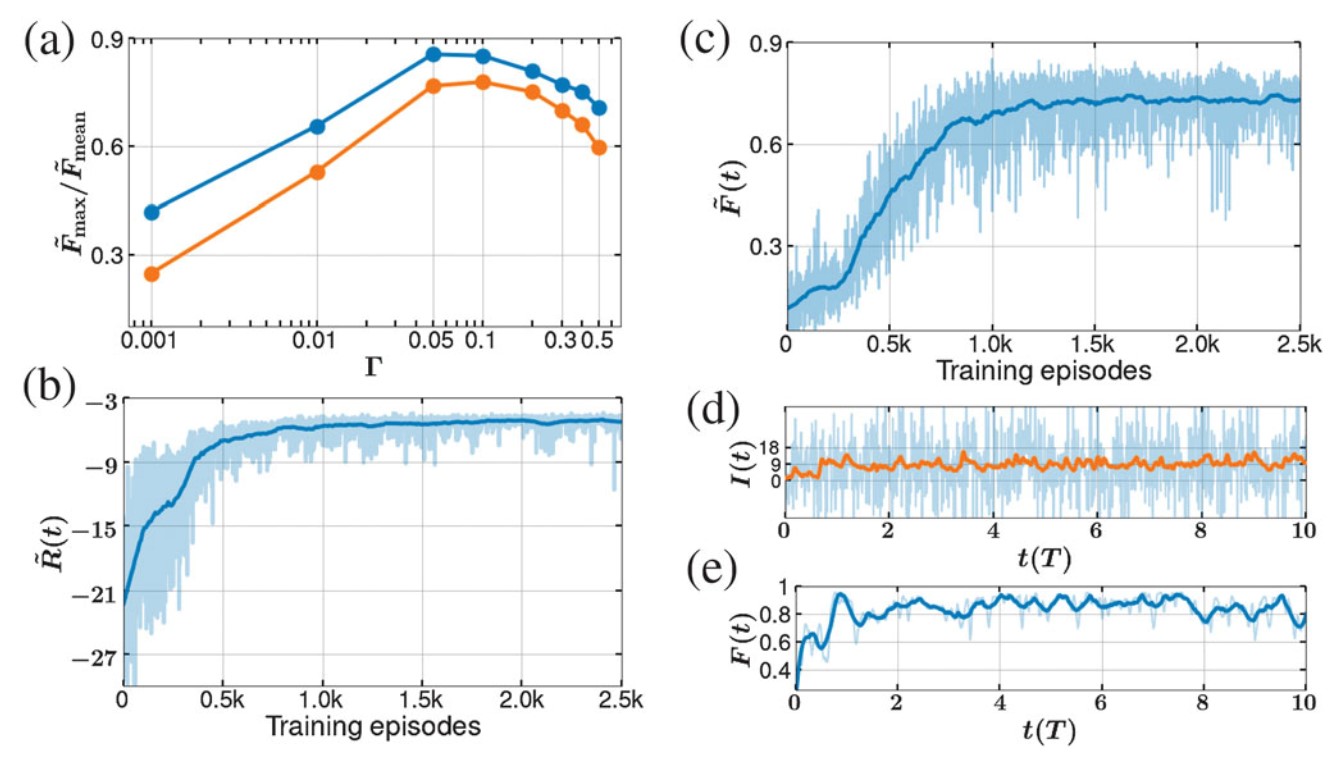
Training the DRL-agent. (a) The dependence of the agent’s performance on the rate of information extracted from the detector (measurement rate). (b) The typical learning curve. (c) Performance of the trained model to control the dynamics of the state near the ground state (fidelity). (d) and (e) The typical dynamics followed by the particle being controlled by the trained agent.
As we gradually move toward a future largely dominated by artificial intelligence (AI), the time is ripe to explore the utility and usability of AI in solving some problems that cannot be solved by conventional means, especially in controlling particle dynamics at the electron or photon level, where the world is dramatically counterintuitive. In this work, we have showcased an example that demonstrates how machine learning can indeed be effective for such control.
Video: Demonstration of performance of the DRL trained agent against the untrained agent to effectively cool the system near to the non-classical quantum ground state.
3.2 Cooling a levitated magnet
Intensive Cavity-Magnomechanical Cooling of a Levitated Macromagnet A. Kani, B. Sarma , and J. Twamley, Phys. Rev. Lett. 128, 013602 (2022).
Microscopic world is governed by the laws of quantum physics. Small particles behave strangely that are very different from our everyday reality and even beyond our intuition. The rules of quantum physics are applicable even for macroscopic objects that are visible to the naked eye, but nobody has witnessed the weird quantum phenomena. Quantum effects are fragile to de- coherences, and sufficiently cooling an object can reveal its quantum behaviour. Cooling the motion of individual atoms and ions towards the quantum motional ground state has been achieved but cooling a large particle remains a formidable challenge. The cooling efficiency crucially depends on its zero-point motion which decreases rapidly with mass and cooling large particles typically not feasible.
We propose a scheme to cool the motion of a levitated spherical magnet where the lowest phonon number that can be achieved is an intensive property - i.e. is independent of the size of the magnet. We achieve this via an effective three mode coupling between a microwave cavity mode, a magnon spin wave mode, and a center-of-mass phonon mode. Magnon, the quantum of collective spin wave excitation enhances the mechanical coupling by a factor of the square root of the total number of spins. The number of spins gets higher with increasing size yields a cooling rate that is intensive. We find it can surpass normal sideband cooling by six orders of magnitude for large millimeter-sized spherical magnets. This three-body intensive cooling scheme can provide a route toward the preparation of massive motional quantum superpositions, the investigation of the interaction of gravity with quantum mechanics, and macroscopic quantum sensors.

Figure: (a) we cool the motion of a trapped magnet (green disc), which is trapped in a harmonic potential (black parabola), by coupling the internal spin waves to a standing microwave field in a microwave cavity which is driven (red arrow); (b) analogy with an optomechanical system; (c) the incredible cooling ability of our scheme: we plot the equilibrium phonon occupation of our scheme (blue line), as compared with traditional cooling schemes (red line), as the radius of the spherical magnet increases. We keep cool!
3.3 Generating nonlinearities from conditional linear operations
Mattias T. Johnsson, Pablo M. Poggi, Marco A. Rodríguez, Rafael N. Alexander, Jason Twamley, “Generating nonlinearities from conditional linear operations, squeezing and measurement for quantum computation and super-Heisenberg sensing”, Physical Review Research 3, 023222 (2021).
Large bosonic or continuous variable nonlinearities can have numerous applications, ranging from the generation of cat-states for quantum computation, through to quantum sensing where the sensitivity exceeds Heisenberg scaling inthe resources. We describe a novel protocol where one can effectively generate large Kerr-type nonlinearities via the conditional application of a linear operation on a probe mode by an ancilla mode, followed by a measurement of the ancilla and corrective operation on the probe mode. Our protocol can generate high quality Schrodinger cat states useful for quantum computing and can be used to perform sensing of an unknown rotation or displacement in phase space, with super-Heisenberg scaling in the resources. We describe a potential experimental implementation using atomic ensembles interacting with optical modes via the Faraday effect.
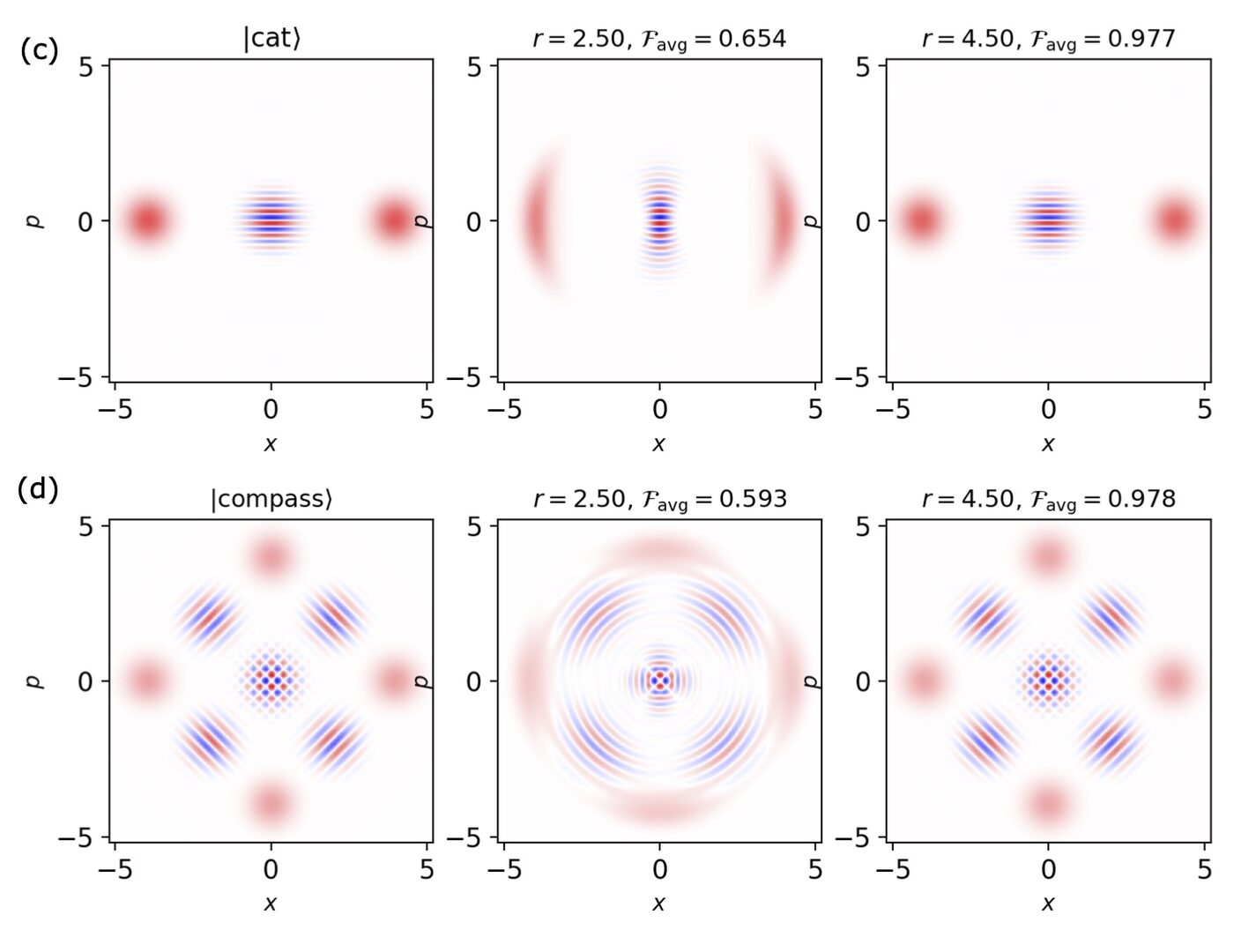
Fig 3. Using the quantum circuit for generating higher order nonlinearities to build bosonic cat or compass states. Left column: Wigner functions of target quantum states, Middle column: Achieved Wigner functions at low levels of squeezing, Right column: Wigner functions achieved at higher levels of squeezing.
4. Publications
4.1 Journals
-
Kani, A., Sarma, B. and Twamley, J.
Intensive Cavity-Magnomechanical cooling of a levitated macromagnet
Phys Rev Lett 128, 013602 (2021) -
Borah, S., Sarma, B., Kewming, M., Milburn, G.J. and Twamley, J.
Measruement-based feedback quantum control with deep reinforcement learning for a double-well nonlinear potential
Phys Rev Lett 127, 190403 (2021) -
Khalique, A., Sett, A., Wang, J. and Twamley, J.
Controlled information transfer in continuous-time chiral quantum walks.
New J. Physics 23, 083005 (2021) -
Johnsson, M.T., Poggi, P.M., Rodriguez, M.A., Alexander, R.N., and Twamley, J.
Generating nonlinearities from conditional linear operations, squeezing, and measurement for quantum computation and super-Heisenberg sensing.
Phys. Rev. Research 3, 023222 (2021).
4.2 Books and other one-time publications
Nothing to report
4.3 Oral and Poster Presentations
-
S. Tian, Invited Oral Seminar Presentation: Generation of macroscopic quantum motional superpositions using superconducting quantum circuits, May 6, 2022
University College London, London -
S. Tian, Contributed Poster Presentation: Generation of macroscopic quantum motional superpositions using superconducting quantum circuits, April 25-29, 2022
“Quantum Engineering of Levitated Systems” conference, Benasque, Spain -
J. Twamley, Oral Seminar Presentation: Towards quantum sensing using nonlinear quantum systems, Dublin Institute for Advanced Studies, Dublin, Ireland, Dec 2021 - video
-
J. Twamley, Invited Seminar: Magnetic Quantum Engineering, Quantum Information & Quantum Gravity Online, seminars May, 2021 - video
5. Intellectual Property Rights and Other Specific Achievements
To be advised
6. Meetings and Events
6.1 Virtual Seminars
1. Prof. Sam Reiter and Prof. Jason Twamley, OIST
- Title: Celebrate the International Day of Light Live with Cephi the Cephalopod
- Date: May 16, 2021
- Time: 08:00
- Seminar details: https://groups.oist.jp/qmech/event/celebrate-international-day-light-live-cephi-cephalopod
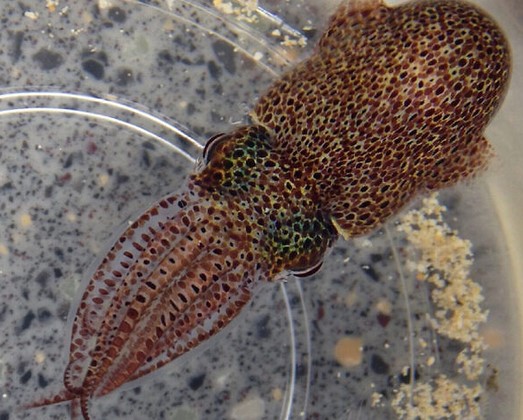
2. Prof. Girish S. Agarwal, Texas A&M University
- Title: Cavity Magnonics: From Anti-PT symmetry to Quantum Entanglement
- Date: August 11, 2021
- Time: 10:00
- Seminar details: https://groups.oist.jp/qmech/event/cavity-magnonics-anti-pt-symmetry-quantum-entanglement
- Group website: https://physics.tamu.edu/directory/girish-agarwal/
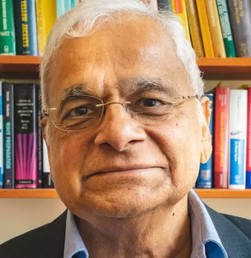
3. Prof. Peter Steeneken, Delft University of Technology
- Title: Nanomechanics for probing the physics of 2D materials by Prof. Peter Steeneken
- Date: August 18, 2021
- Time: 16:00
- Seminar details: https://groups.oist.jp/qmech/event/seminar-nanomechanics-probing-physics-2d-materials-prof-peter-steeneken
- Group website: https://www.tudelft.nl/3me/over/afdelingen/precision-and-microsystems-engineering-pme/people/professors/profdr-pg-peter-steeneken
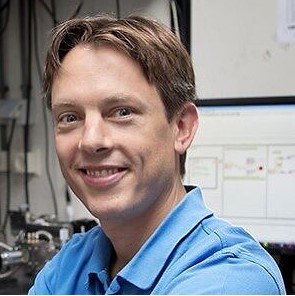
4. Prof. Johannes M. Fink, Institute of Science and Technology Austria
- Title: Quantum-enabled operation of a microwave-optical interface
- Date: October 27, 2021
- Time: 16:00
- Seminar details: https://groups.oist.jp/qmech/event/seminar-quantum-enabled-operation-microwave-optical-interface-prof-johannes-m-fink
- Group website: https://ist.ac.at/en/research/fink-group/
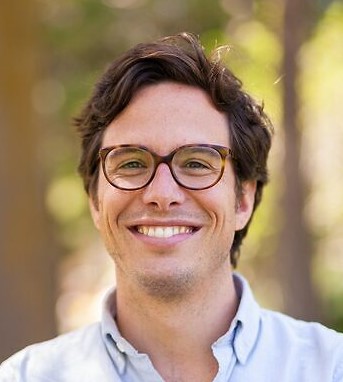
5. Dr. J. Eli Bourassa and Dr. Ilan Tzitrin, Xanadu
- Title: Blueprint for a Scalable Photonic Fault-Tolerant Quantum Computer
- Date: November 24, 2021
- Time: 10:00
- Seminar details: https://groups.oist.jp/qmech/event/blueprint-scalable-photonic-fault-tolerant-quantum-computer
- Group website: https://www.xanadu.ai/

6. Dr. Bill Munro, NTT Basic Research Laboratories & NTT Research Center for Theoretical Quantum Physics
- Title: Non-linear effects in Hybrid Quantum Systems
- Date: November 26, 2021
- Time: 10:00
- Seminar details: https://groups.oist.jp/qmech/event/seminar-non-linear-effects-hybrid-quantum-systems
- Group website: https://www.rd.ntt/e/organization/researcher/superior/s_019.html
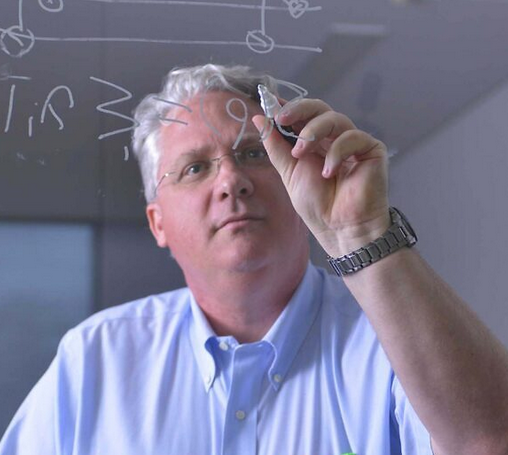
7. Dr. Mohan Sarovar, Sandia National Labs in California, USA
- Title: Quantum-inspired manifold learning and feedback-based quantum optimization
- Date: January 19, 2022
- Time: 10:00
- Seminar details: https://groups.oist.jp/qmech/event/seminar-quantum-inspired-manifold-learning-and-feedback-based-quantum-optimization
- Group website: https://sites.google.com/site/sarovar

8. Dr. Adarsh Ganesan, the US National Institute of Standards and Technology
- Title: Phononic Frequency Combs
- Date: May 18, 2022
- Time: 09:00
- Seminar details: https://groups.oist.jp/qmech/event/seminar-phononic-frequency-combs
- Google scholar: https://scholar.google.co.in/citations?hl=en&user=7Nxn2aQAAAAJ&view_op=list_works&sortby=pubdate

7. Other
7.1 Events at OIST
Small Workshop: "Macroscopic Quantum Machines" (April 7, 2022)
https://groups.oist.jp/qmech/event/seminars-macroscopic-quantum-machines
Speakers:
- Prof Minowa (Osaka University)
- Dr Fuwa (Gakushuin University)
- Dr Kani (OIST)
- Dr Borah (OIST)
Prof. Yosuke Minowa, Graduate School of Engineering Science, Osaka University
Title: Cryogenic Optical Tweezers and more
Dr. Maria Fuwa, Quantum Measurement Group, Department of Physics, Faculty of Science, Gakushuin University
Title: Meissner Levitation of Soft Ferrimagnetic Insulators
Dr Kani, Quantum Machines Unit, OIST
Title: Cavity-Magnonic Control on Mechanical Motion of a Levitated Macromagnet
Dr Borah, Quantum Machines Unit, OIST
Title: Continuous Quantum Error Correction using Measurement Based Estimation

7.2 Community Outreach Activities
Nothing to report



